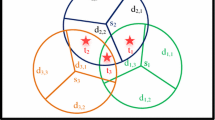Abstract
A directional sensor network consists of a large number of directional sensors (e.g., image/video sensors), which have a limited angle of sensing range due to technical constraints or cost considerations. In such directional sensor networks, the power saving issue is a challenging problem. In this paper, we address the Directional Cover and Transmission (DCT) problem of organizing the directional sensors into a group of non-disjoint subsets to extend the network lifetime. One subset in which the directional sensors cover all the targets and forward the sensed data to the sink is activated at one time, while the others sleep to conserve their energy. For the DCT problem proven to be the NP-complete problem, we present a heuristic algorithm called the Shortest Path from Target to Sink (SPTS)-greedy algorithm. To verify and evaluate the proposed algorithm, we conduct extensive simulations and show that it can contribute to extending the network lifetime to a reasonable extent.
Similar content being viewed by others
References
Ai J, Abouzeid AA (2006) Coverage by directional sensors in randomly deployed wireless sensor networks. J Comb Optim 11:21–41
Akyildiz IF, Melodia T, Chowdhury K (2007) A survey on wireless multimedia sensor networks. Comput Netw 51:921–960
Cai Y, Lou W, Li M, Li XY (2009) Energy efficient target-oriented scheduling in directional sensor networks. IEEE Trans Comput 58:1259–1274
Cardei M, Du DZ (2005) Improving wireless sensor network lifetime through power aware organization. Wirel Netw 11(3):333–340
Cardei M, Wu J (2006) Energy-efficient coverage problems in wireless ad-hoc sensor networks. Comput Commun 29(4):413–420
Cardei M, Thai MT, Li Y, Wu W (2005) Energy-efficient target coverage in wireless sensor networks. In: IEEE Infocom, pp 1976–1984
Chang JH, Tassiulas L (2004) Maximum lifetime routing in wireless sensor networks. IEEE/ACM Trans Netw 12(4):609–619
Chen J, Koutsoukos X (2007) Survey on coverage problems in wireless ad hoc sensor networks. In: IEEE SouthEastCon
Chen J, Salim MB, Matsumoto M (2011) A single mobile target tracking in Voronoi-based clustered wireless sensor network. J Inf Process Syst 7(1):17–28
Hall JL (2001) Handbook of multisensor data fusion. CRC Press, Boca Raton
Huang CF, Tseng YC (2005) A survey of solutions to the coverage problems in wireless sensor networks. J Internet Technol 6(1):1–8
Ilyas M, Mahgoub I (2004) Handbook of sensor networks: compact wireless and wired sensing systems. Florida Atlantic University, Boca Raton
Li D, Wong K, Hu Y, Sayeed A (2002) Detection, classification, tracking of targets. IEEE Signal Process Mag 19(2):17–29
Liu H, Wan PJ, Jia X (2006) Maximal lifetime scheduling for sensor surveillance systems with K sensors to 1 target. IEEE Trans Parallel Distrib Syst 17(12):1526–1536
Liu H, Jia X, Wan PJ, Yi CW, Makki SK, Pissinou N (2007) Maximizing lifetime of sensor surveillance systems. IEEE/ACM Trans Netw 15(2):334–345
Liu K, Xiong J (2010) A fine-grained localization scheme using a mobile beacon node for wireless sensor networks. J Inf Process Syst 6(2):147–162
Lu M, Wu J, Cardei M, Li M (2005) Energy-efficient connected coverage of discrete targets in wireless sensor networks. In: Int conf of computer networks and mobile computing (ICCNMC)
Ma H, Liu Y (2005) Correlation based video processing in video sensor networks. IEEE Wirel Commun 987–992. doi:10.1109/WIRLES.2005.1549547
Ma H, Liu Y (2005) On coverage problems of directional sensor networks. In: The first int conf on mobile ad-hoc and sensor networks, pp 721–731
Ma H, Tao D (2006) Multimedia sensor network and its research progresses. J Softw 17:2013–2028
Rahimi M, Baer R, Iroezi O, Garcia J, Warrior J, Estrin D, Srivastava M (2005) Cyclops: in situ image sensing and interpretation in wireless sensor networks. In: Proc ACM conf embedded networked sensor systems
Wang J, Niu C, Shen R (2009) Priority-based target coverage in directional sensor networks using a genetic algorithm. Comput Math Appl 57:1915–1922
Wang X, Xing G, Zhang Y, Lu C, Pless R, Gill C (2003) Integrated coverage and connectivity configuration in wireless sensor networks. In: Proc ACM int conf embedded networked sensor systems, pp 28–39
Zhao Q, Gurusamy M (2007) Lifetime maximization for connected target coverage in wireless sensor networks. IEEE/ACM Trans Netw 16(6). doi:10.1109/TNET.2007.911432
Zhou G, He T, Krishnamurthy S, Stankovic JA (2006) Models and solutions for radio irregularity. Wirel Sens Netw 2(2):221–262
Author information
Authors and Affiliations
Corresponding author
Rights and permissions
About this article
Cite this article
Kim, Yh., Han, YH., Jeong, YS. et al. Lifetime maximization considering target coverage and connectivity in directional image/video sensor networks. J Supercomput 65, 365–382 (2013). https://doi.org/10.1007/s11227-011-0646-9
Published:
Issue Date:
DOI: https://doi.org/10.1007/s11227-011-0646-9




